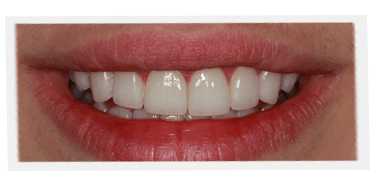
These four problems are typically treated with orthodontic movements but can be treated alternatively with various restorative dental techniques. When the latter approach is chosen, the procedure involved is referred to as “non-orthodontic alignment.” Under this category, patients – whether because of age or personal preference – have decided to undergo dental solutions. Unlike orthodontic treatments, the roots are kept in their current position and the teeth are covered with porcelain (commonly referred to as porcelain veneers or crowns). Following are some general comments on all four of these problems. (Taken from my book, A Guide to the Perfect Smile.)
Gaps
Most people do not find gaps between teeth attractive overall. The gaps create a dark silhouette, an artificial border, which causes the eye to see black. This bothers us because we are aesthetically trained to want to see continuity in the teeth as they stretch back into the mouth.
This effect is even worse when the teeth are also crooked. Such teeth create curved lines, forming a silhouette that looks like the opposite of an hourglass. The shape of the black against the white creates an off-looking space that isn’t symmetrical to the general look of the teeth. The spaces suggest to our eye an imbalance in form and therefore a lack of genetic harmony – because in such a case the gene that dictates the size of the teeth is out of sync with the gene that dictates the size of the jaw. Genetically, then, properly spaced teeth give a signal of good genes overall.
However, even where the teeth are straight, any gaps between them will look unpleasant to most people. One theory is that this looks reminds us of our evolutionary past. Early man’s lower teeth were much larger than his upper teeth, for the purposes of fighting, hunting, and chewing. However, these larger lower teeth needed spaces to fit into, much as gears need spaces in order to mesh together. This setup was no longer necessary or desired as man evolved and began to eat cooked and softer meats and to use weapons.
The space between the two front teeth is called the “midline diastema,” and it is sometimes thought, by wearers or viewers, to be attractive. Thin of the famous actors Madonna, Laura Hutton, and Eddie Murphy. However, there are in fact mathematical and scientific principles for measuring the relative width and proportion of teeth, leading to a more precise determination of what the “perfect gap” should be.
Solution: The following focuses on closing the gap between the two front teeth, but the principles apply to any gaps.
Before a patient and dentist decide to close the midline diastema, the most common gap problem, they should consider five general principles:
1. The gap may be acceptable – it conforms to the correct proportions of the teeth.
2. The patient may prefer the gap and choose to leave it.
3. The patient may not be prepared to undergo the other treatments that may be necessary to treat and close the gap.
4. The patient may have unreal expectations regarding what they will look like with the gap closed.
5. The closing of the gap may make the other teeth around it look unnatural because of discrepancies in jaw size and tooth size.
If the patient does choose to have the gap closed, the biggest challenge will be adding width to the teeth. If the patient already has teeth that are too narrow, then closing the gap is an opportunity to widen them and give them proper proportion. But more often than not, the teeth are already naturally proportioned. Widening them in order to close the gap creates an unreal and disproportionate appearance. Treating this requires a compensatory process involving one of four variables:
1. Gingival height can be increased. By doing this, the dentist is adding length to compensate for the greater.
2. Incisal length can be increased. Doing this helps achieve proportionality, especially in patients who already don’t show enough of their teeth when they smile or speak.
3. The mesial contact (toward the center of the body) or distal contact (toward the outside of the body) can be relocated. When a gap needs to be closed, it is these surfaces that need to be changed. By definition, closing the gap involves two teeth. In deciding how to close the gap, the question must be answered: Do we add to the surface of one tooth or the other tooth, or do we split the difference and add to both?
4. A multidimensional approach is sometimes required. In these cases, many techniques are involved to give natural-looking results. To properly close the gap and create a very natural look, the gum line may have to be reduced; the gingival height increased; incisal length increased; and teeth built up on either side of the space, thereby minimizing the amount of change that is called for. This technique of spreading the artificial amounts over many different surfaces so that no one surface involves too much of a change is known as “mortgaging.”
Edward S. Philips, D.D.S.



